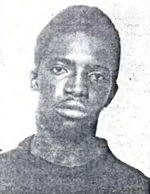 Inside Detective, June 1977. William Ward, a 21-year-old black bricklayer from Tuscaloosa, Alabama, was sentenced to ten years for the first-degree manslaughter of Walter Dillard, who was shot at a bar on May 31, 1975. Club 61 was an entertainment spot frequented by the black community in Tuscaloosa. On the night of May 31, 1975, William Ward and his two sisters, Cora and Mary, and a friend, Janie Dillard, were seated together at a table at Club 61. Janie, 19, was married to Walter Dillard, a friend of William Ward. Sometime after midnight, Walter Dillard entered the club, spotted his wife seated with the Wards and grabbed her, striking her across the face. Despite cries from those in the Club pleading with Dillard to stop beating his wife, the assault continued. Dillard dragged his wife to the parking lot, ignoring those who tried to come to Janie Dillard’s rescue. The beating ended when gunshots were fired, striking Dillard in the forehead. Rushed to the hospital, Dillard died shortly thereafter. Several eyewitnesses claimed to have seen Ward with a gun on the night of the shooting, one of whom identified Ward as the man he had seen shoot Dillard. Ward was soon charged in Dillard’s death. His trial began on October 13, 1975. A forensic expert testified that the murder weapon was a .22 caliber gun. Among the eye witnesses who testified were Ward’s sisters. His sister Cora testified that the man who shot Dillard was wearing a brown suit and a hat, which was not the clothing worn by Ward on the night of the shooting. Ward was convicted of first-degree manslaughter and sentenced to ten years in prison. Two years later, the original investigator, Tuscaloosa Detective Shirley Fields, who was never comfortable with the conviction, recalled finding a bullet casing from a .25 caliber gun at the crime scene. Ward, who had not previously admitted having a gun, even to his attorney, revealed to Fields that he had been in possession of a gun on the night of the shooting and that, in the commotion, the gun had accidentally discharged. Fields located the weapon that belonged to Ward: it was a .25 caliber gun. Thus, the bullet casing found at the crime scene came from Ward’s gun and this explained why witnesses claimed to have seen him with a weapon. Ward’s gun was not, however, the weapon that had killed Dillard. Armed with this new evidence, Ward’s attorney returned to court where the judge concluded that Ward couldn’t have killed Dillard that night because he had a .25 and not a .22 caliber weapon. The judge ordered a new trial. The charges were then dismissed, and Ward was released in March 1977. “I owe a lot to you,” Ward told Detective Fields. “A lot of officers would have quit once they got me in jail. But you didn’t. You worked.” – Researched by Dolores Kennedy
|